Join More Than 50,000+ Subscribers and get latest camera news and rumors
NEW CAMERA VIDEOS ON YOUTUBE
|
By admin, on February 27th, 2012
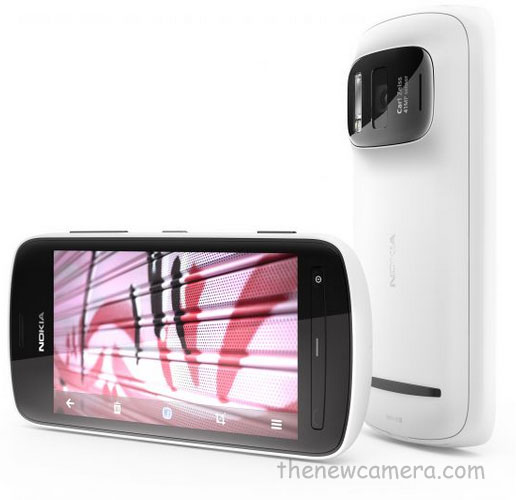 Nokia today announced 808 PureView Smart Phone with 41MP Sensor, the phone uses pixel oversampling, in a nutshell it means the combination of many pixels into one perfect pixel. The Nokia PureView imaging technology is the result of many years of research and development and the tangible fruits of this work are amazing image quality, lossless zoom, and superior low light performance. Nokia today announced 808 PureView Smart Phone with 41MP Sensor, the phone uses pixel oversampling, in a nutshell it means the combination of many pixels into one perfect pixel. The Nokia PureView imaging technology is the result of many years of research and development and the tangible fruits of this work are amazing image quality, lossless zoom, and superior low light performance.
Nokia 808 PureView Camera Specification
- 41 megapixel camera sensor with Nokia Pureview Pro imaging technology and Carl Zeiss optics
- Fullscreen 16:9 viewfinder with easy on-screen touch controls
- Xenon flash with operating range up to 3.5 m depending on conditions. Automatic fill-flash
- LED for video recording
- Focal length: 8.02 mm (35 mm equivalent focal length -26 mm, 16:9 / 28 mm, 4:3)
- Auto focus and touch to focus
- Focus modes: Hyperfocal, Macro, Infinity and Auto
- Focus range: 15 cm ~ infinity
- Macro focus 15-50 cm
- F number/aperture: F2.4
- Supported aspect ratios and resolutions True 16:9 (2 MP, 5 MP [Default], 8 MP, 41 MP) 4:3 (3 MP, 5 MP, 8 MP, 41 MP)
- Three shooting modes: Auto, Scenes, Creative
- Face detection software
- Launch camera from lock with full press of capture key
Nokia 808 PureView High Resolution Sample Images
More: Nokia pureview data sheet PDF
Press Release
Barcelona, Spain – Nokia today ushered in a new era in high-end smartphone imaging with the Nokia 808 PureView. This is the first smartphone to feature Nokia PureView imaging technologies, bringing together high resolution sensors, exclusive Carl Zeiss optics and Nokia developed algorithms, which will support new high-end imaging experiences for future Nokia products.
The Nokia 808 PureView features a large, high-resolution 41 megapixel sensor with high-performance Carl Zeiss optics and new pixel oversampling technology. At standard resolutions (2/3, 5 and 8 megapixels) this means the ability to zoom without loss of clarity and capture seven pixels of information, condensing into one pixel for the sharpest images imaginable. At high-resolution (38 megapixel maximum) it means the ability to capture an image, then zoom, reframe, crop and resize afterwards to expose previously unseen levels of details. With superior low-light performance and the ability to save in compact file sizes for sharing in email, MMS, and on social networks, the Nokia 808 PureView makes it possible for anyone to capture professional looking images in any conditions.
In addition to superior still imaging technology, the Nokia 808 PureView, also includes full HD 1080p video recording and playback with 4X lossless zoom and the world’s first use of Nokia Rich Recording. Rich Recording enables audio recording at CD-like levels of quality, previously only possible with external microphones. The Nokia 808 PureView also features exclusive Dolby Headphone technology, transforming stereo content into a personal surround sound experience over any headphones and Dolby Digital Plus for 5.1 channel surround sound playback.
“Nokia PureView imaging technology sets a new industry standard by whatever measure you use,” said Jo Harlow, executive vice president of Nokia Smart Devices. “People will inevitably focus on the 41 megapixel sensor, but the real quantum leap is how the pixels are used to deliver breath-taking image quality at any resolution and the freedom it provides to choose the story you want to tell.”
By admin, on February 27th, 2012

Buy Fuji X-Pro1 from – Amazom || B&H || Adorama
Do you Remember when few days ago fuji said “resolution and low noise of upcoming FujiFilm X mirrorless interchangeable lens camera will surpass the 35mm full size sensor”.., Now a Japanese blog published 100% cropped images of X-Pro1 and Canon 5D Mark II taken at ISO 400 to 6400, in JPG and RAW mode (converted via SILKYPIX) , the results will surprise anyone.

See more images here – dslr-check.info/2012/0222.jpg
News src / Via – fotoactualidad
By admin, on February 27th, 2012
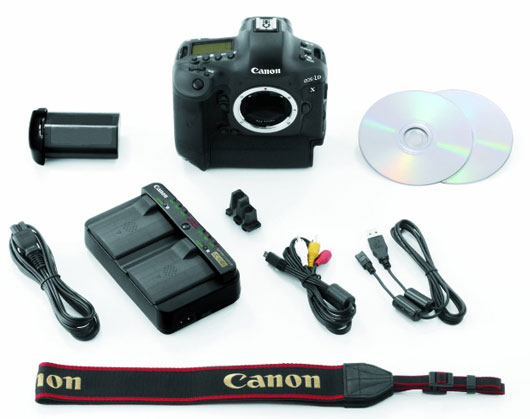
According to Canon Japan the Canon 1D X is bit delayed due to some kind of development issue,
Translated from Japanese
Thank you patronage is thick wilt give us special courtesies.
So now we can with the “accessories on sale and the same time digital SLR SLR Camera EOS-1D X”, to change the release date as described below, I guide.
The release date Summary of Changes
| Product Name |
Will be released (so far) |
(The current outlook) will be released |
| EOS-1D X |
Late March 2012 |
Late April 2012 |
| GPS receiver GP-E1 |
April 2012 |
Late April 2012 |
| Wireless File Transmitter WFT-E6B |
Late March 2012 |
Late April 2012 |
| Battery Charger LC-E4N |
Late March 2012 |
Late April 2012 |
| Battery Pack LP-E4N |
Late March 2012 |
Late April 2012 |
| L7 Wide Strap |
Late March 2012 |
Late April 2012 |
| Focusing Screen Ec-CV |
Late March 2012 |
Late April 2012 |
- ※Regarding concrete release date, I guide as soon as it becomes clear again.
News src – Canon Japan
See more
about Canon 1DX and
Nikon D4 vs Canon 1DX
By admin, on February 26th, 2012
Canon recently updated high-end 24-70mm f/2.8 II USM standard zoom and two completely redesigned semi-fast 24mm and 28mm f/2.8 primes. All the three lenses are now available for pre – order at Amazon.
Click on the image to visit Amazon
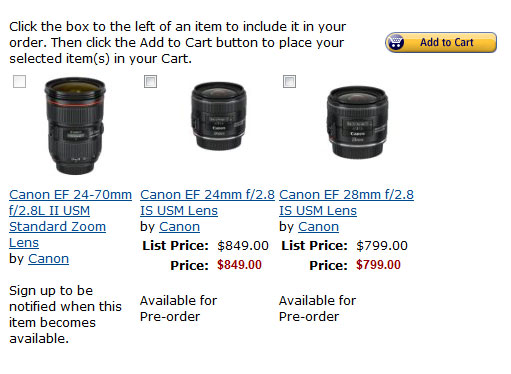
By admin, on February 25th, 2012
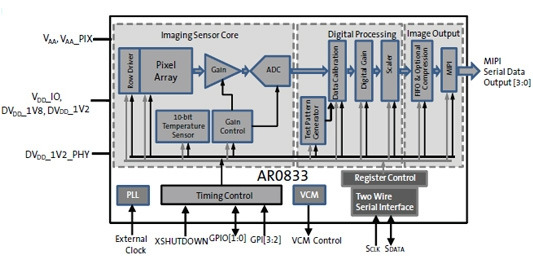 The new Aptina AR0833 1/3.2” format 1.4-micron pixel sensor can captures 8MP stills and Full HD movies. Additionally, the AR0833 is HDR ready for still and video applications capturing difficult high range scenes when coupled with an HDR processor. The new Aptina AR0833 1/3.2” format 1.4-micron pixel sensor can captures 8MP stills and Full HD movies. Additionally, the AR0833 is HDR ready for still and video applications capturing difficult high range scenes when coupled with an HDR processor.
Aptina™ A-PixHS™
A-PixHS™ technology brings together Aptina’s backside illuminated (BSI) pixel technology and an advanced high speed sensor architecture to enable a new class of high performance cameras. The BSI pixel maximizes the efficiency with which the light is captured by inverting the sensor to put the photo sensitive region closer to the lens and by implementing advanced engineering techniques found in AptinaTM A-PixTM technology. The advanced high-speed sensor architecture leverages the speed and sensitivity of the BSI pixel to enable fast, vivid video and image capture.
The AR0833 is currently sampling and will be available in mass production CY Q2 2012.
By admin, on February 25th, 2012
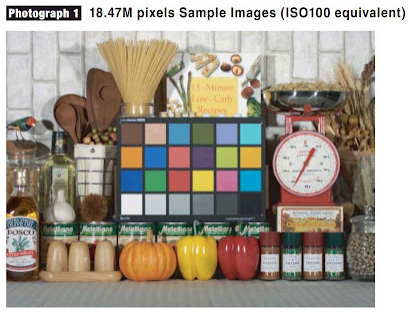 Sony announced new (IMX118CQT) 18MP BSI (Type 1/2.3) Sensor for use in consumer digital cameras, currently Sony is using this sensor in its TX 200V ultra slim camera. Sony announced new (IMX118CQT) 18MP BSI (Type 1/2.3) Sensor for use in consumer digital cameras, currently Sony is using this sensor in its TX 200V ultra slim camera.
Compared to current Sony (IMX078CQK) 12 MP BSI CMOS sensor the new (IMX118CQT) 18MP BSI Sensor is 80% faster, consumes 35% less energy and produces low noise.
Main features
■ Diagonal 7.76 mm (Type 1/2.3) 18.47M-effective pixels (4968H × 3718V)
■ Pixel size: 1.26 µm unit pixel
■ Supports 18.47M-pixel imaging at approx. 24 frame/s
■ Back-illuminated CMOS image sensor that achieves both higher pixel count and high picture quality
■ Achieves low-power readout mode (1632H × 408V, 30 frame/s) for live view
By admin, on February 25th, 2012
 Read the Canon G1 X vs. Nikon V1 vs. Panasonic GX1 review to find out the best camera for you. Read the Canon G1 X vs. Nikon V1 vs. Panasonic GX1 review to find out the best camera for you.
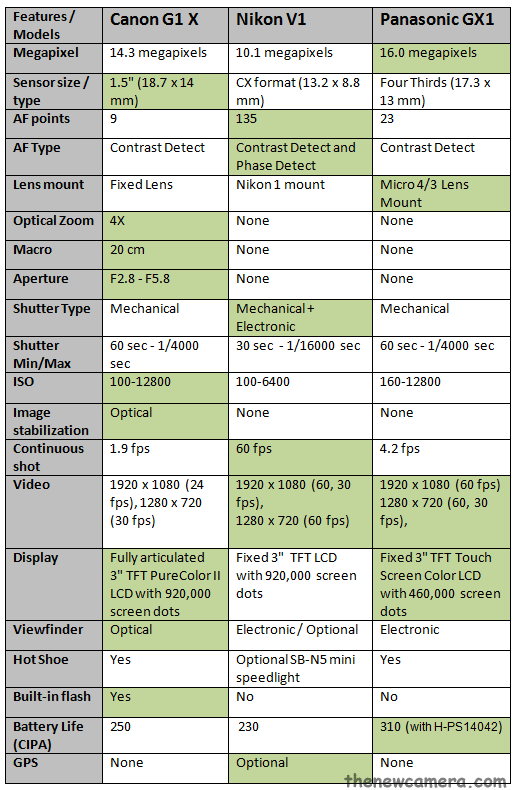
Sensor and image processor
Canon G1 X uses newly developed 1.5 inch 14.3 CMOS sensor with DIGIC V image processor, with the new sensor and image processor you get more dynamic range, better ISO range and less noise in your images.
Panasonic uses 16 megapixel M 4/3 sensor and venus FHD image processor, the Venus FHD processor is the same processor used in GH2 / GF2 / GF3 / G3 mirrorless cameras.
Nikon V1 uses a small CX format sensor but very fast Expeed 3 image processor, you get Continuous shot up to 60 Shot/Sec.
Noise Levels & Dynamic Range: Large sensors with larger pixels produce low noise and higher dynamic range.
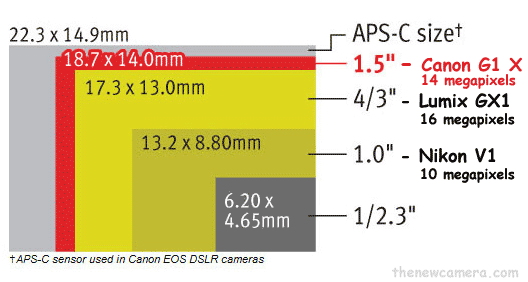
ISO: The ISO rating on Nikon 1 is limited to 6400, Panasonic Lumix GX1 ISO range is 160 to 12800 and Canon G1 X ISO range is 100 to 12800, the overall ISO range of Canon G1 X is better compared than the Nikon V1 and Panansonic Lumix GX1.
Auto Focus: Nikon V1 uses Hybrid AF system with both phase and contrast detection with 135 AF points, Panasonic GX1 features 23 AF point with contrast detection and Canon G1 X uses contrast detection AF system and comes with only 9 AF points
Shutter Speed – If we look at the type of shutter and image processor used in all these three camera, the Nikon V1 comes out as a clear winner
|
Shutter Type |
Continuous shooting |
Shutter |
| Min |
Max |
| Nikon 1 |
Mechanical + Electronic |
10 fps – Mech. Shutter60fps – Elect. shutter |
30 sec |
1/16000 sec |
| Lumix G1X |
Mechanical |
4.2 fps |
60 sec |
1/4000 sec |
| Canon GX 1 |
Mechanical |
1.9 fps |
60 sec |
1/4000 sec |
Lenses Many options available with Panasonic Lumix GX1, you get wide range of high quality optics including fast prime lenses.
The Canon G1 X comes with a compact 4X optical zoom lens, the Nikon 1 have very limited range of Nikon 1 Lenses.
Pocketable: Canon G1 X with fixed 4X optical Zoom Lens and Panasonic Lumix GX1 with collapsible kit zoom can easily fit in your jacket pocket, Nikon 1 lenses are big and need more space / travel bag.
Video: Both Nikon and Panasonic and Lumix offer Full HD Video recording at 60 fps, Canon G1 X Full HD video recording is limited to 30 fps only.
Display: The Canon G1 X comes with Fully articulated 3″ TFT PureColor II LCD with 920,000 screen dots, The Panasonic GX1 features with Fixed 3″ TFT Touch Screen Color LCD with 460,000 screen dots and finally Nikon V1 with Fixed 3″ TFT LCD with 920,000 screen dots.
View finder: Canon G1X features Optical viewfinder, Nikon V1 have Electronic viewfinder and Panasonic Lumix GX1 have optional Electronic viewfinder.
Conclusion:
Canon G1 X is the best compact camera ever made, highly recommended for event shooters, photojournalist, nature & Landscape photographers, In a very tight compact body you get 1.5inch sensor, ISO up to 12800 and high quality 4X optical zoom lens.
Panasonic GX1, Comes with bit smaller sensor compared GX 1 features better video mode and new X series of contractible zoom lens are highly optimized for video shooting, , with four third format you also get a wide range of high quality optics including fast prime lenses.
Nikon 1 system is highly recommended for sports & Action Photographers, it features advance AF system and continuous shooting up to 60fps, but remember the sensor size is small compared to Canon G1 X and Panasonic GX1 (you get limited dynamic and ISO range).
Buy Canon G1 X from Amazon || B&H |||
Buy Nikon V1 from Amazon || B&H ||| Amazon UK
Buy Panasonic GX1 from Amazon || B&H ||| Amazon UK
|
KEEP THIS BLOG ALIVE - Support New Camera Buy Canon Lenses, Buy Music CD or Digital Camera at amazon it helps this site, and you do not pay anything extra, it is just a way to help support this site.

|
 Nokia today announced 808 PureView Smart Phone with 41MP Sensor, the phone uses pixel oversampling, in a nutshell it means the combination of many pixels into one perfect pixel. The Nokia PureView imaging technology is the result of many years of research and development and the tangible fruits of this work are amazing image quality, lossless zoom, and superior low light performance.
Nokia today announced 808 PureView Smart Phone with 41MP Sensor, the phone uses pixel oversampling, in a nutshell it means the combination of many pixels into one perfect pixel. The Nokia PureView imaging technology is the result of many years of research and development and the tangible fruits of this work are amazing image quality, lossless zoom, and superior low light performance.













